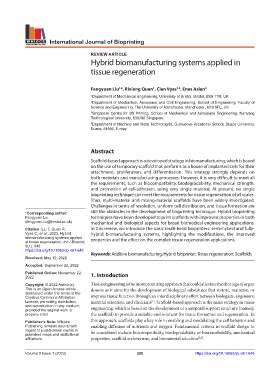Page 328 - IJB-9-1
P. 328
International Journal of Bioprinting
REVIEW ARTICLE
Hybrid biomanufacturing systems applied in
tissue regeneration
1
2,3
Fengyuan Liu *, Rixiang Quan , Cian Vyas , Enes Aslan 4
1
1 Department of Mechanical Engineering, University of Bristol, Bristol, BS8 1TR, UK
2 Department of Mechanical, Aerospace and Civil Engineering, School of Engineering, Faculty of
Science and Engineering, The University of Manchester, Manchester, M13 9PL, UK
3 Singapore Centre for 3D Printing, School of Mechanical and Aerospace Engineering, Nanyang
Technological University, 639798 Singapore
4 Department of Machine and Metal Technologies, Gumusova Vocational School, Duzce University,
Duzce, 81850, Turkey
Abstract
Scaffold-based approach is a developed strategy in biomanufacturing, which is based
on the use of temporary scaffold that performs as a house of implanted cells for their
attachment, proliferation, and differentiation. This strategy strongly depends on
both materials and manufacturing processes. However, it is very difficult to meet all
the requirements, such as biocompatibility, biodegradability, mechanical strength,
and promotion of cell-adhesion, using only single material. At present, no single
bioprinting technique can meet the requirements for tissue regeneration of all scales.
Thus, multi-material and mixing-material scaffolds have been widely investigated.
Challenges in terms of resolution, uniform cell distribution, and tissue formation are
*Corresponding author: still the obstacles in the development of bioprinting technique. Hybrid bioprinting
Fengyuan Liu techniques have been developed to print scaffolds with improved properties in both
(fengyuan.liu@bristol.ac.uk) mechanical and biological aspects for broad biomedical engineering applications.
Citation: Liu F, Quan R, In this review, we introduce the basic multi-head bioprinters, semi-hybrid and fully-
Vyas C, et al., 2023, Hybrid hybrid biomanufacturing systems, highlighting the modifications, the improved
biomanufacturing systems applied
in tissue regeneration. Int J Bioprint, properties and the effect on the complex tissue regeneration applications.
9(1): 646.
https://doi.org/10.18063/ijb.v9i1.646
Keywords: Additive biomanufacturing; Hybrid bioprinter; Tissue regeneration; Scaffolds
Received: May 12, 2022
Accepted: September 22, 2022
Published Online: November 22,
2022 1. Introduction
Copyright: © 2022 Author(s). Tissue engineering is the most promising approach that could alleviate the shortage of organ
This is an Open Access article donors as it aims for the development of biological substitutes that restore, maintain, or
distributed under the terms of the
Creative Commons Attribution improve tissue function through an interdisciplinary effort between biologists, engineers,
License, permitting distribution, material scientists, and clinicians . Scaffold-based approach is the main strategy in tissue
[1]
and reproduction in any medium,
provided the original work is engineering, which is based on the development of a temporal support structure (namely,
properly cited. the scaffold) to provide a suitable environment for tissue formation and regeneration. In
Publisher’s Note: Whioce this approach, scaffolds play a key role in enabling and modulating the cell behavior and
Publishing remains neutral with enabling diffusion of nutrients and oxygen. Fundamental criteria in scaffold design to
regard to jurisdictional claims in
published maps and institutional be considered include biocompatibility, biodegradability or bioresorbability, mechanical
affiliations. properties, scaffold architecture, and biomaterial selection [2,3] .
Volume 9 Issue 1 (2023) 320 https://doi.org/10.18063/ijb.v9i1.646

